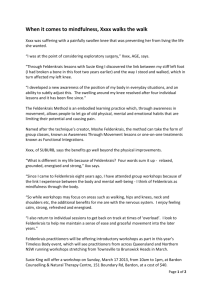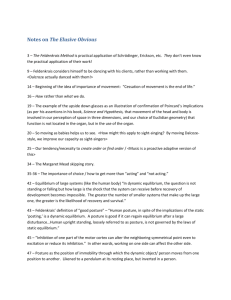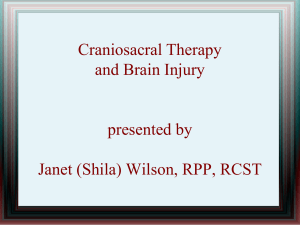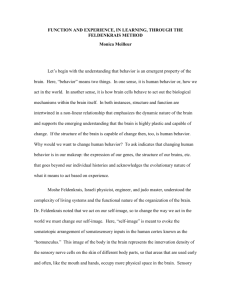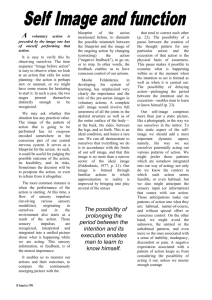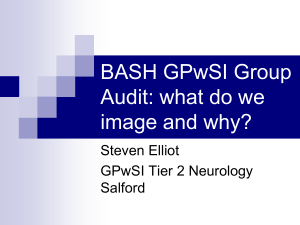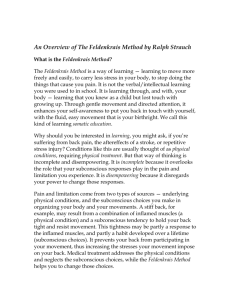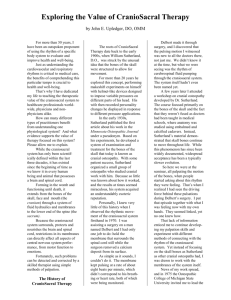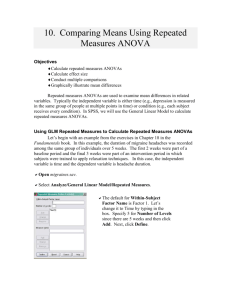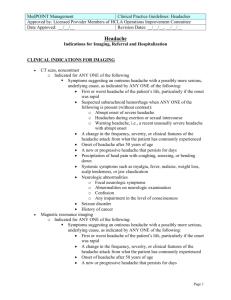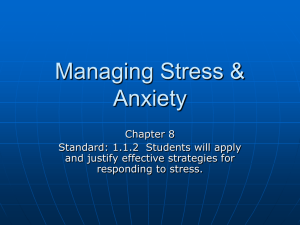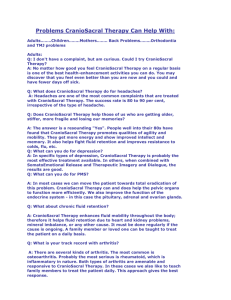When Stephanie first appeared in my office three years ago, she
advertisement
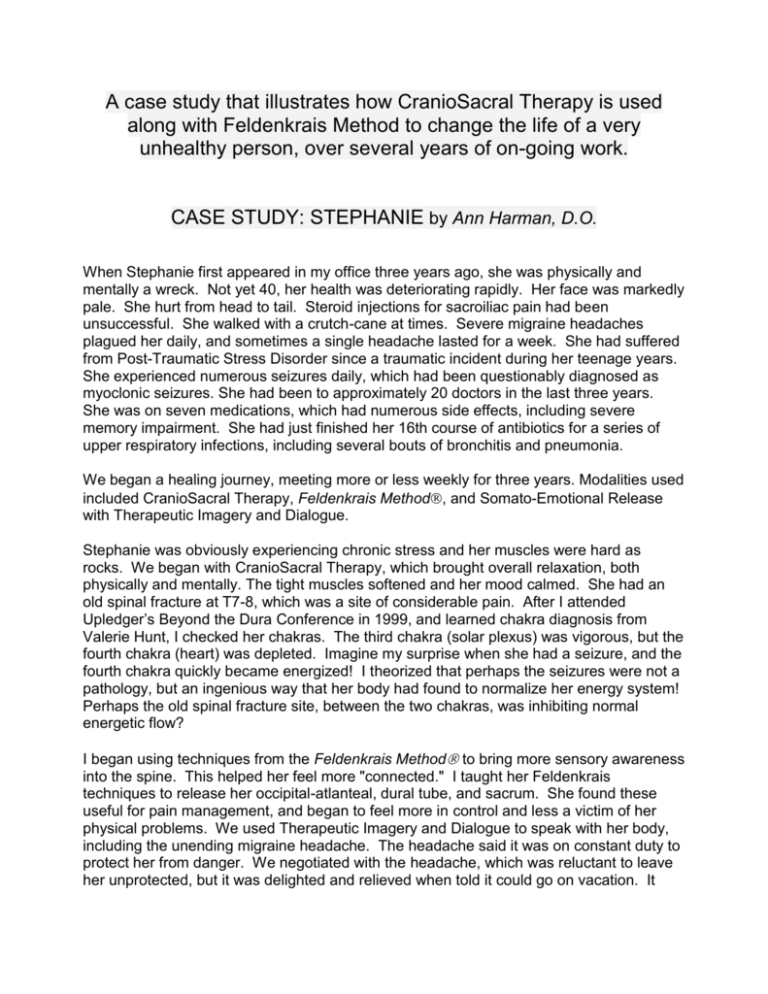
A case study that illustrates how CranioSacral Therapy is used along with Feldenkrais Method to change the life of a very unhealthy person, over several years of on-going work. CASE STUDY: STEPHANIE by Ann Harman, D.O. When Stephanie first appeared in my office three years ago, she was physically and mentally a wreck. Not yet 40, her health was deteriorating rapidly. Her face was markedly pale. She hurt from head to tail. Steroid injections for sacroiliac pain had been unsuccessful. She walked with a crutch-cane at times. Severe migraine headaches plagued her daily, and sometimes a single headache lasted for a week. She had suffered from Post-Traumatic Stress Disorder since a traumatic incident during her teenage years. She experienced numerous seizures daily, which had been questionably diagnosed as myoclonic seizures. She had been to approximately 20 doctors in the last three years. She was on seven medications, which had numerous side effects, including severe memory impairment. She had just finished her 16th course of antibiotics for a series of upper respiratory infections, including several bouts of bronchitis and pneumonia. We began a healing journey, meeting more or less weekly for three years. Modalities used included CranioSacral Therapy, Feldenkrais Method, and Somato-Emotional Release with Therapeutic Imagery and Dialogue. Stephanie was obviously experiencing chronic stress and her muscles were hard as rocks. We began with CranioSacral Therapy, which brought overall relaxation, both physically and mentally. The tight muscles softened and her mood calmed. She had an old spinal fracture at T7-8, which was a site of considerable pain. After I attended Upledger’s Beyond the Dura Conference in 1999, and learned chakra diagnosis from Valerie Hunt, I checked her chakras. The third chakra (solar plexus) was vigorous, but the fourth chakra (heart) was depleted. Imagine my surprise when she had a seizure, and the fourth chakra quickly became energized! I theorized that perhaps the seizures were not a pathology, but an ingenious way that her body had found to normalize her energy system! Perhaps the old spinal fracture site, between the two chakras, was inhibiting normal energetic flow? I began using techniques from the Feldenkrais Method to bring more sensory awareness into the spine. This helped her feel more "connected." I taught her Feldenkrais techniques to release her occipital-atlanteal, dural tube, and sacrum. She found these useful for pain management, and began to feel more in control and less a victim of her physical problems. We used Therapeutic Imagery and Dialogue to speak with her body, including the unending migraine headache. The headache said it was on constant duty to protect her from danger. We negotiated with the headache, which was reluctant to leave her unprotected, but it was delighted and relieved when told it could go on vacation. It wanted to go to the beach! We asked it to board a helicopter, and gave it the romance novel and Dr. Seuss book that it requested. It soon returned, but we had many more conversations, with much reassurance that it could safely leave. Gradually, the headache had longer periods of absence, and when it reappeared it was less severe. Other parts of the brain, including the hypothalamus, Reticular Alarm System, and corpus callosum, were brought into the conversation. The corpus callosum was afraid to allow the two halves of the brain to communicate. We convinced it to allow just 10 percent through, as an experiment. Stephanie felt markedly different after that session, and found an increase in creativity afterward. She was quite pleased with this, as her hobby is writing fiction. We convinced the Reticular Alarm System to lower its vigilance and allow more sleep. The hypothalamus had been living in terror. Reassuring conversation with it helped her color to normalize and helped the overall functioning of her whole body. She saw a bioenergetic therapist during times of high stress, which complemented her therapy with me. Now Stephanie is a changed woman. She never needs the cane, and can walk the mall, as well as perform physical tasks such as lifting boxes. She gets a mild headache two or three times weekly, and the severe headache happens only once every few months. Her pain is under control; seizures are occasional and are no longer an issue. Post-traumatic stress symptoms are markedly reduced. She dialogues with her headache, corpus callosum, and hypothalamus, which gives insight into her emotions and physical symptoms. She uses self-help techniques from the Feldenkrais Method to manage pain and stress, and uses the CranioSacral Therapy ear pull technique to normalize her temporal bones. She has discontinued the most dangerous and debilitating medications, no longer has disabling side effects, and has regained her memory. When I asked her to summarize the effects of therapy, she replied, "I'm alive now. I don't think I would be without this." Ann Harman is an osteopathic physician, CranioSacral Therapist, and Guild Certified Feldenkrais Practitioner, who lives in Micanopy, Florida (near Gainesville). She teaches “Applications of the Feldenkrais Method for CranioSacral Therapists,” “The Inspiring Breath and the Inquiring Mind,” and “Avenue of Expression: A Feldenkrais Approach” through Upledger Institute. She may be contacted afn29901@afn.org or afn29901@netzero.net
